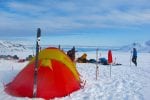Do you dream of skiing down steep slopes – in a completely unique landscape?
We travel by boat from Longyearbyen and establish a basecamp on the glacier. From this camp we will climb up and ski on the surrounding peaks. On Spitsbergen (Svalbard’s largest island) you have perfect conditions for skiing in the month of May. At this point, the sun never sets and therefore we let the weather instead of the clock determine when we should ski. The temperature rarely drops below -5 ° C. We spend the night in warm sleeping bags in our expedition tent.
Contact form

Ecorating: 3.0
This product meets our requirements for Ecorating, a product that is good for humans and the environment.
Does my trip make a difference?
Read more
This product meets our requirements for Ecorating, a product that is good for humans and the environment.
Sample Itinerary

We meet at the hotel in Longyearbyen at 8, from where the bus brings us down to the port and the waiting boat. We get all our equipment on board and go out into the fjord. During the trip in the beautiful fjord there will be plenty of time to enjoy the landscape and the magnificent wildlife. We arrive at our destination after lunch.
The goal the first day is to get up on the glacier and find a good place for our basecamp. We got the camp in place by noon and then enjoyed a well-deserved meal. As the sun moves west, we crawl into our sleeping bags. Or maybe you have enough energy for an evening excursion up the Polhøgda mountain, 689 masl – the trip is approx. 6 km.

After breakfast we climb up to some of the beautiful peaks at the Esmark Glacier. After a long day in the mountains, it will feel nice to relax a bit in the camp and eat a good dinner. For the tough ones, there will be the option of an evening walk before sleep calls.

Today the guide chooses the route according to weather and snow conditions. But today, in any case, we must move the camp over the Geolog Pass down the Kjerulf Glacier in the direction of the Protector Glacier and a nearby bay. In the evening we climb or ski on some of the surrounding mountain peaks. Distance: approx. 14 km on skis.

From the camp we can choose from a number of fantastic ski routes. The view from the surrounding mountains is a fantastic reward when you look out of breath, and another magnificent experience awaits as we whiz down the mountain again. The area here offers ski routes that range from medium to very difficult. Maybe we should grab one last ride under the midnight sun?

We start early with the unpacking of the camp. Then it’s time for the last ski trip before we drive to the beach and transport ourselves back to Longyearbyen. During the four-hour trip we have at sea, we have plenty of time to say goodbye to the landscape and let some of the new impressions sink in completely. Arrival at Basecamp Trappers Hotel in the afternoon / early evening. Distance on skis: approx. 4 km.
Trip details
When can you travel? May
Travel duration: 5 nights
Minimum age: 18 years
Airport: Longyearbyen, Norway
The price includes: International flight, accommodation and meals according to the program, transport to and from accommodation. Equipment: tent, sleeping bag, mattress, Primus kitchen and fuel, kitchen equipment, emergency equipment, mountain sled or Paris expedition sled. Search and rescue insurance.
The price does not include: Activities outside the program, drinks at meals, CO2 compensation NOK 250, transfer from the airport by airport bus or on your own.
Good to know about Svalbard
Despite Svalbard’s northern location, the archipelago has a relatively mild climate compared to other areas at the same latitude. In summer the temperature is around 5 ° C and usually very little rain, but it is quite common with fog and low clouds. Although it rarely rains, the ground is often wet due to the melting snow. Cold winds are common, even in summer. It must be remembered that the weather on Svalbard can change quickly and local temperatures can vary greatly.
In winter, the average temperature is -14 ° C. Temperatures between -20 and -30 degrees are not uncommon. In combination with wind, temperatures can be extremely low.
Longyearbyen has midnight sun from 19 April to 23 August. During this bright period, the sun never goes below the horizon. In contrast, from late October to mid-February, the sun never appears above the horizon. The dark polar nights last from mid-November to the end of January, and during this period you can not distinguish day from night.
Visa: Danish citizens do not need a visa to Norway.
Time Zone: GMT +1
Vaccination: No vaccinations required.
Packing: With the right packing, plenty of food and good daily routines, you can stay warm, even on cold days. This is of course important so that you can enjoy your Arctic adventure. We recommend everyone to wear wool and stock in stock, wool socks in both summer and winter season. The wind on Svalbard can be strong, and if it blows over the glacier it can feel very cold.
Packing list: We recommend that you bring the following equipment: A solid backpack, bag for personal belongings, warm windproof jacket and trousers, warm down jacket / parka, warm windproof hat, 2 pairs of wool gloves, 1 pair of windproof gloves, 1 pair of work gloves (when handling dogs, etc.), 2 sets of wool underwear and sweater, warm wool or fleece jacket, wool or fleece trousers, 2-3 pairs of wool socks, toiletries, sunglasses, binoculars and camera. Due to limited space in the sleds, we recommend that you bring a minimum of luggage (the remaining luggage can be stored at the Basecamp Trappers Hotel).
Included: All guests receive a warm overall, snow boots, windproof gloves, face mask, goggles and a warm hat. In addition, warm sleeping bags, sleeping pads, tents and necessary camping equipment will be included. Our experienced guide takes care of the guests’ safety and brings all the necessary safety equipment.
Local currency: Norwegian kroner
Weather: Weather Svalbard ondmi.dk
Mobile coverage and internet: The mobile network works well in Norway. Basecamp management recommends that you use your phone discreetly or turn it off.
Safety: Safety instructions are provided on site when you arrive and it is VERY important to follow them. Meeting a polar bear is a great experience, but can also be extremely dangerous situation. All guides are armed around the clock to ensure your safety.

Ecorating: 3.0
This product meets our requirements for Ecorating, a product that is good for humans and the environment.
Does my trip make a difference?
Read more
This product meets our requirements for Ecorating, a product that is good for humans and the environment.
At Basecamp Spitsbergen, people are particularly concerned about the global warming of the planet, as it is most visible in our polar regions. The biggest project we can contribute to address this is by planting trees in Kenya. All guests are encouraged to participate in the project. By planting trees, we can reduce CO2 emissions globally. Your contribution is 250 NOK, which is equivalent to being able to plant 8 trees in Kenya.
In Svalbard, you use as few resources as possible, and use organic products to keep your environmental footprint as small as possible.
At Isfjord Radio an indoor herbal garden has been initiated that supplies the chef with fresh herbs and supplements for the guests’ meals, saving CO2 emissions.
Basecamp Explorer Spitsbergen has also supported the Kapp Linne information project on how to raise awareness on the valued bird sanctuary and its birdlife, managing visitors when experiencing the reserve.
Basecamp Explorer Spitsbergen regularly takes part in clean up activities around the islands.




